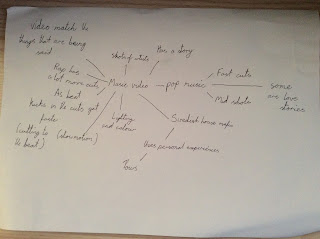In his book Dancing in the Distraction Factory (1992) Andrew Goodwin points out characteristics and features that can be found in music videos.
1. Music videos demonstrate genre characteristics.
(e.g. stage performance in metal videos, dance routine for boy/girl band, aspiration in Hip Hop).
(e.g. stage performance in metal videos, dance routine for boy/girl band, aspiration in Hip Hop).
2. There is a relationship between lyrics and visuals.
The lyrics are represented with images - either illustrating, amplifying or contradicting them.
The lyrics are represented with images - either illustrating, amplifying or contradicting them.
3. There is a relationship between music and visuals.
The tone and atmosphere of the visuals reflect that of the music - either illustrating, amplifying or contradicting.
The tone and atmosphere of the visuals reflect that of the music - either illustrating, amplifying or contradicting.
4. The demands of the record label will include the need for lots of close ups of the artist and the artist may develop motifs which recur across their work (a visual style).
5. There is frequently reference to notion of looking (screens within screens, mirrors, stages, etc) and particularly voyeuristic treatment of the female body.
6. There are often intertextual reference (to films, tv programmes, other music videos etc).
(From Andrew Goodwin, DANCING IN THE DISTRACTION FACTORY, 1992.)












